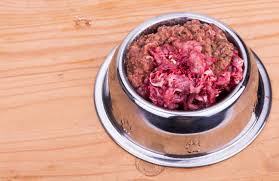
Which food is right for your dog? Kibble or raw diets?
There is a lot of differing opinion about what is best for your dog. Pet food manufacturers will obviously say that kibble is best however kibble is fully processed and if you refer to a previous blog HERE you will see the process it goes through to get made.
Also be aware that diet should be based on size of your dog, level of activity (working dog, household pet) and age.
Raw Dog Food
A raw dog food diet commonly consists of:
- Organ meats
- Muscle meat
- Whole or ground bone
- Raw eggs
- Dog-safe fresh fruits and vegetables
- Some dairy, such as yogurt
Supporters of raw food claim the potential benefits to be:
- Shinier coats
- Healthier skin
- Improved dental health
- Increased energy
- Smaller stools
A raw food diet is typically more expensive than a processed kibble diet.
Raw food diets are not recommended in homes with small children or immunocompromised individuals. This is due to the health risk raw foods can present. However, there are still many raw food diet advocates. If a dog owner elects to pursue this type of diet, find a veterinarian who is familiar with raw foods and can help guide you in the proper handling and cleaning required to prevent possible health concerns.
Their high-protein formulas combine dry kibble with freeze-dried raw meat pieces, helping to take the guesswork and potential risks out of feeding raw.
Dry Dog Kibble
Dry food ingredients vary by brand, but all kibble dog foods are required to be balanced and meet the nutritional needs of a dog. In fact, the content, calories, and nutritional value of commercially prepared pet meals and treats are regulated by law. The ingredients in dry dog food kibble are processed together and cooked.
These required ingredients include:
- Protein sources like beef, poultry, fish, and eggs
- Grains
- Cereals
- Vitamins, minerals, and antioxidants
Supporters of dry dog food kibble claim the potential benefits to be:
- Reduced dental plaque
- Healthier gums
- Reduced risk of bacteria
- Easier storage
- Less risk of spoilage
- Cost-effective
As with all foods, reading the label will help you find the best possible brand for your dog. Always remember that the first ingredient is the most prevalent in that food.
Look for a food that has a protein as the first ingredient, not a grain. The best dry dog foods have a single or novel source of protein, such as lamb, chicken, or salmon. Grain-free diets exist, but carbohydrates are required for energy, especially in rapidly growing, large-breed puppies and very active dogs. The choice of grain, however, is important. Some dogs may have sensitivities to wheat, corn, or soybeans. All dry dog foods need preservatives to prevent the fat from becoming rancid.
Personally, I am a believer in dogs having a balanced diet. My 3 spoilt dogs eat a different meal each night. Their diet includes: kibble, sardines, vegetables, rice, pasta, dog roll, chicken, cooked mince, spinach, yogurt, eggs, fresh chicken necks and wings for teeth health and occasionally can food.